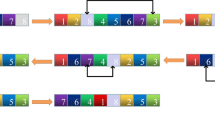Abstract
With the rapid development of GIS and computer technology, the geo-spatial data has been widely used in many fields. Since the production of geo-spatial data is very costly, illegal copying will lead to huge loss of the data owner. In order to protect the copyright of geo-spatial data, digital watermarking has been employed in recent years. In this paper, current works on geo-spatial watermarking and cardinal attacks are analyzed. Consequently, a blind watermarking scheme for polylines in vector geo-spatial data is proposed. In the proposed scheme, FVDR (feature vertex distance ratio) is constructed based on the feature vertices of polylines. As the cover data, FVDR is slightly modified through quantization index modulation to embed the corresponding watermark bit. Each bit in the watermark is embedded in several polylines, by doing so each of these polylines contains a copy of the corresponding watermark bit. Because of the specially designed cover data, quantization modulation and redundant embedding, the proposed scheme is robust to geometrical attacks, vertex attacks and object attacks. Also, the results of extensive experiments demonstrate the robustness of the proposed scheme.












Similar content being viewed by others
References
Ahmed AM (2004) Digital image watermarking using fuzzy logic and naturalness preserving transform, Ph.D. Thesis of Kansas State University
Arnold VI, Avez A (1968), vol 296. W. A. Benjamin, New York
Bazin C, Le Bars JM, Madelaine J (2007) A blind, fast and robust method for geographical data watermarking. ACM Symp Info Comput Commun Secur:265–272
Bird S, Bellman C, Schyndel RV (2009) A Shape-based Vector Watermark for Digital Mapping. Digit Image Comput Tech Appl:454–461
Cao L, Men C, Li X (2010) Iterative embedding-based reversible watermarking for 2D-vector maps, 17th. IEEE Int Conf Image Proc:3685–3688
Chang HJ, Jang BJ, Lee SH, Park SS, Kwon KR (2009) 3D GIS Vector Map Watermarking Using Geometric Distribution. ICME:1014–1017
Chen B, Wornell W (2001) Quantization Index Modulation: A Class of Provably Good Methods for Digital Watermarking and Information Embedding. IEEE Trans Info Theory 47:1423–1443
Cox IJ, Miller ML, Bloom JA (2007) Digital watermarking. Morgan Kaufmann, New York
Douglas DH, Peucker TK (1973) Algorithms for the reduction of the number of points required to represent a digitized line or its caricature. Can Cartogr 10:112–122
Giannoula A, Nikolaidis N, Pitas I (2002) Watermarking of sets of polygonal lines using fusion techniques. Proc IEEE Int Conf Multimedia Expo:549–552
Hou HS, Andrews HC (1978) Cubic Splines for Image Interpolation and Digital Filtering. IEEE Trans Acoust Speech Signal Process 26:508–517
Huang M, Zhou X, Cao JH, Peng ZY (2007) Geo-WDBMS: an improved DBMS with the function of watermarking geographical data. DASFAA:1098–1109
Kang H, Kim K, Choi J (2001) A vector watermarking using the generalized square mask. Proc Int Symp Info Technol Coding Comput:234–236
Kim J (2010) Vector map digital watermarking using angles. Sixth Int Conf Netw Comput Adv Info Manag (NCM2010):417–423
Kim J (2010) Robust Vector Digital Watermarking Using Angles and a Random Table. Adv Info Sci Serv Sci 2:79–90
Kim J, Won S, Zeng W, Park S (2011) Copyright protection of vector map using digital watermarking in the spatial domain, 7th International Conference on Digital Content. Multimedia Technol Appl:154–159
Lee SH, Kwon KR (2013) Vector watermarking scheme for GIS vector map management. Multimedia Tools Appl 63:757–790
Liu S, Ma T (2012) Linear Data Relocation and Reconstruction Algorithm for Vector Map. Proceedings Int Conf Info Eng Appl:529–535
Niu XM, Shao CY, Wang XT (2007) GIS watermarking: hiding data in 2D vector maps. Studies in Computational Intelligence 58:123–155
Ohbuchi R, Ueda H (2002). Endoh S, Robust watermark of vector digital maps, 2002 IEEE International Conference on Multimedia and Expo:577–580
Pu Yu-Chi, Jou I-Chang (2009) Blind and robust watermarking for street-network vector maps. Info Technol J 8:982–989
Sakamoto M, Matsuura Y, Takashima Y (2000) A scheme of digital watermarking for geographical map data. Symp Crypt Info Secur
Shen T, Xu D, Li C, Sun J (2009) Watermarking GIS Data for Digital Map Copyright Protection. Proc 24th Int Cartogr Conf:15–21
Schulz G, Voigt M (2004) A high capacity watermarking system for digital maps. Proc 2004 multimedia Secur Work multimedia Secur:180–186
Solachidis V, Nikolaidis N, Pitas I (2004) Watermarking polygonal lines using Fourier descriptors. Comput Graph Appl 24:44–51
Voigt M, Yang B, Busch C (2004) Reversible Watermarking of 2D-Vector Data. Proc 2004 Work Multimedia Secur:160–165
Voigt M, Yang B, Busch C (2005) High-capacity reversible watermarking for 2D-Vectordata, Proc. SPIE 5681, Security. Steganography Watermarking Multimedia Contents VII:409–417
Wang CJ, Peng ZY, Peng YW, Yu L, Wang JZ, Zhao QZ (2012) Watermarking geographical data on spatial topological relations. Multimedia Tools Appl 57:67–89
Xu D, Wang Q (2010) The study of watermarking algorithm for vector geospatial data based on the phase of DFT, Proc. 2010 IEEE International Conference on Wireless Communications. Netw Info Secur:625–629
Yan H, Li J, Wen H (2011) A key points-based blind watermarking approach for vector geospatial data, Computers. Environ Urban Syst 35:485–492
Zhang D, Qian D, Wu W, Liu A, Yang X, Han P (2007) Spatial Map Data Share and Parallel Dissemination System Based on Distributed Network Services and Digital Watermark. IFIP Int Fed Info Proc:71–80
Zhang L, Yan D, Jiang S, Shi T (2010) New robust watermarking algorithm for vector data. Wuhan Univ J Nature Sci 15:403–407
Zope-Chaudhari S, Venkatachalam P (2012) Protecting geospatial data using digital watermarking. 2012 Int Conf Comput Commun Eng:594–598
Acknowledgements
The authors gratefully acknowledge the anonymous reviewers for their valuable comments. This work is supported by the National Natural Science Foundation of China (NSFC, Grant No.61100019 and 61262021). The work was done while the corresponding author was visiting the School of ITEE at the University of Queensland.
Author information
Authors and Affiliations
Corresponding author
Rights and permissions
About this article
Cite this article
Peng, Z., Yue, M., Wu, X. et al. Blind watermarking scheme for polylines in vector geo-spatial data. Multimed Tools Appl 74, 11721–11739 (2015). https://doi.org/10.1007/s11042-014-2259-9
Received:
Revised:
Accepted:
Published:
Issue Date:
DOI: https://doi.org/10.1007/s11042-014-2259-9




